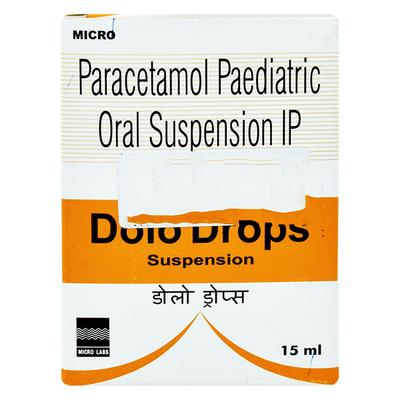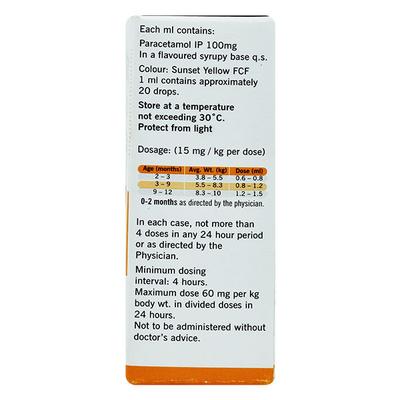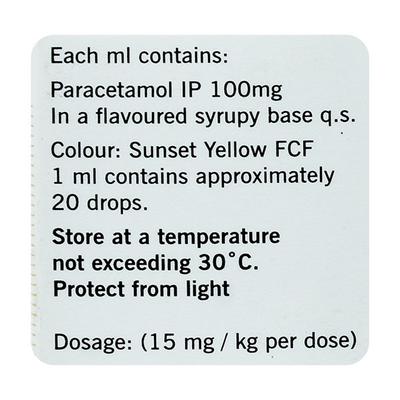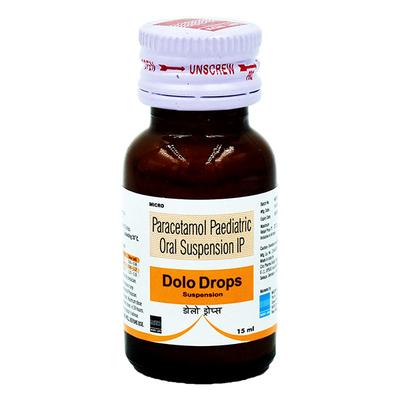

Netmeds First Membership
Quick Links
Introduction About DOLO DROPS
Dolo Drops are antipyretic and analgesic drops that are used in children to manage mild to moderate pain associated with the common cold, influenza, backache, headache, earache, muscle pain, sore throat, teething, toothache, and it is also used to reduce fever, including post-vaccination fever. It contains paracetamol as an active ingredient which blocks the pain and fever-causing mechanism in the body.
Paracetamol works by inhibiting the production of a chemical called prostaglandins in the body which is responsible for causing pain and swelling in the body. It reduces fever by affecting an area of the brain that is responsible for regulating our body temperature called the hypothalamic heat-regulating centre.
Give Dolo Drops to your child as directed by your doctor. It is for oral use only. Slowly dispense the prescribed dosage into your child’s mouth, towards the inner cheeks using the provided dropper. Dolo Drops are not recommended for use in children who are suffering from severe liver impairment. It should be used with caution in children who having impaired kidney and liver function. It is not recommended for use in children less than 1 month of age.
Key Composition
- Paracetamol
Uses Of DOLO DROPS
It is used in children to manage:
- mild to moderate pain associated with common cold, influenza, backache, headache, earache, muscle pain, sore throat, teething, and toothache
- fever, including post-vaccination fever
Side Effects Of DOLO DROPS
Consult your doctor immediately in case your child suffers any allergic reaction or side effects after taking Dolo Drops.
Safety Advice
- Give Dolo Drops to your child as directed by your doctor
- It is for oral use only
- Slowly dispense the prescribed dosage into your child’s mouth, towards the inner cheeks using the provided dropper
- For children between 2-3 months, give 0.6 to 0.8 ml, for 3 to 9 months of age give 0.8 to 1.2 ml, and for 9 to 12 months old children give 1.2 to 1.5 ml
- Minimum dosage interval should be 4 hours
- Dolo Drops are not recommended for use in children who are suffering from severe liver impairment
- Use Dolo Drops with caution in children having impaired kidney and liver function
- It is not recommended for use in children less than 1 month of age
- Inform your doctor if you are giving your child any prescription, non-prescription, or herbal medications before using this medicine
More Information
- Keep Dolo Drops out of the reach and sight of children
- Store at room temperature at below 25°C
FAQs About DOLO DROPS
Q: What is Dolo Drops and why is it prescribed?
A: Dolo Drops are antipyretic and analgesic drops that are used in children to manage mild to moderate pain associated with a common cold, influenza, backache, headache, earache, muscle pain, sore throat, teething, toothache, and it is also used to reduce fever, including post-vaccination fever.
Q: Is Dolo Drops safe for babies?
A: Dolo Drops are meant for use in babies and children, hence, it is safe to use. It is not recommended for use in babies below 1 month of age.
Q: How many hours is Dolo Drops effective?
A: Dolo drops have paracetamol which begins to ease pain and lower a high temperature about 30 minutes after a dose is taken. Its effects usually last for about 4 to 6 hours. However, it may depend on an individual’s disease condition.
Q: How should I give Dolo Drops to my child?
A: Dolo Drops are for oral use only. Give this medicine to your child as directed by your doctor. You must use the same dropper, you got with Dolo drops. Fill the dropper up to recommended dose mark and slowly dispense the medicine into your child’s mouth, towards the inner cheeks.
Q: How many times a day can I give Dolo drops to my child?
A: Maintain at least 4 hours of time gap between two doses. Do not give more than 4 doses in 24 hours. Ask for your doctor’s advice before giving it to your child.
References
1. http://www.microlabsltd.com/elibrary/node/1782
2. https://www.ciplamed.com/content/fevago-suspensiondrops
3. https://www.healthdirect.gov.au/paracetamol
4. https://www.ncbi.nlm.nih.gov/pmc/articles/PMC6701828/











